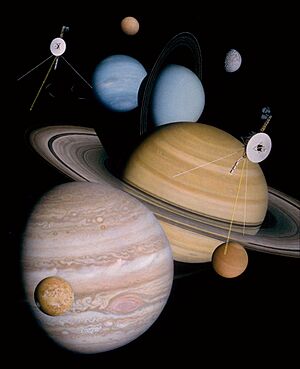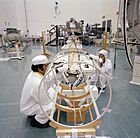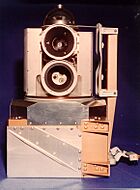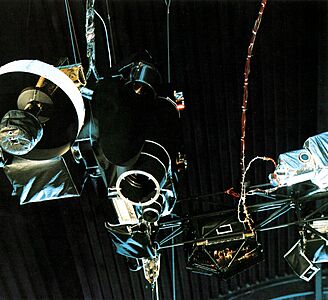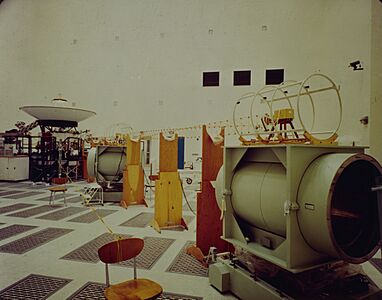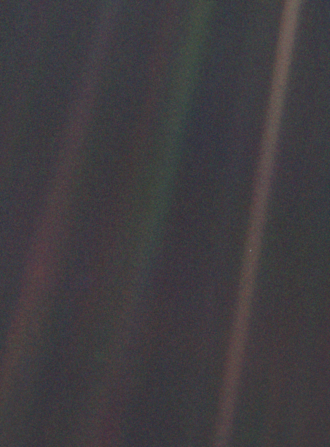Voyager program facts for kids
The Voyager program is a science project from the United States. It uses two space probes, Voyager 1 and Voyager 2. These probes were launched in 1977. Their main goal was to fly past and study the giant planets Jupiter and Saturn. They also had a chance to visit Uranus and Neptune.
After Voyager 1 successfully flew past Saturn and its moon Titan, scientists decided to send Voyager 2 to Uranus and Neptune. Once these planetary flybys were done, the probes continued their journey. They were sent to explore interstellar space, which is the space between stars, and the very outer parts of our Solar System.
On August 25, 2012, Voyager 1 officially entered interstellar space. Voyager 2 followed on November 5, 2019. This means they are now beyond the Sun's main influence. In August 2018, NASA confirmed a "hydrogen wall" at the edge of the Solar System. The Voyager spacecraft first detected this wall in 1992.
As of 2024, both Voyagers are still working. They are now far beyond the heliosphere, which is like a giant bubble of solar wind around our Sun. Voyager 1 is moving at about 61,198 kilometers per hour (17 km/s). It is about 24.4 billion kilometers from the Sun. Voyager 2 is moving at about 55,347 kilometers per hour (15 km/s). It is about 20.4 billion kilometers from the Sun.
The two Voyager probes are the only human-made objects that have traveled into interstellar space so far. Voyager 1 is the farthest object ever sent from Earth by humans.
Contents
History of the Voyager Mission
How the Mission Started
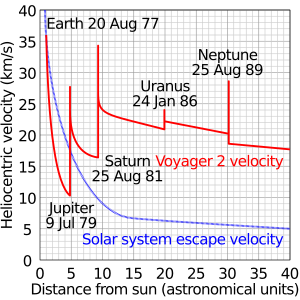
The idea for the Voyager probes came from a bigger plan in the 1960s and 70s. This plan was called the "Planetary Grand Tour." It aimed to explore Jupiter, Saturn, Titan (Saturn's moon), Uranus, Neptune, and Pluto. This was possible because the planets were lined up in a special way that happens only once every 175 years. This alignment allowed spacecraft to use the gravity of one planet to get a "slingshot" boost to the next. This method is called a gravitational assist.
The original Grand Tour mission was canceled in 1971. But in 1972, a smaller mission was proposed. It would use two spacecraft based on the earlier Mariner series. These spacecraft were first called Mariner 11 and Mariner 12. They were later renamed Mariner Jupiter-Saturn because their design was much more advanced than previous Mariner probes.
The Voyager Probes are Named
On March 4, 1977, NASA held a competition to rename the mission. They felt "Mariner Jupiter-Saturn" wasn't quite right. The name Voyager was chosen. Even though the name changed close to launch, some people still called them Mariner 11 and Mariner 12.
Scientists planned two main paths for the probes. One path, called JST, focused on Jupiter, Saturn, and a close flyby of Titan. The other, JSX, was a backup plan. If JST worked, JSX could continue to Uranus and Neptune. If JST failed, JSX could be redirected to Titan instead.
Voyager 2 was launched first. Its path allowed it to visit Jupiter, Saturn, Uranus, and Neptune. Voyager 1 was launched after Voyager 2. But it took a shorter, faster path designed for a close look at Titan. This close flyby sent Voyager 1 out of the plane where most planets orbit, ending its main planetary mission. If Voyager 1 couldn't have flown past Titan, Voyager 2's path could have been changed to visit Titan instead of Uranus and Neptune.
The probes' main goal was to compare Jupiter and Saturn. They would study their atmospheres, magnetic fields, rings, and moons. After their flybys, they would send data back to Earth using special instruments. These instruments would detect particles and radiation from space. The probes' power source, called RTGs, would limit how long they could communicate, probably for about a decade. After their main missions, the probes would keep drifting into interstellar space.
In the 1990s, Voyager 1 passed the earlier Pioneer 10 and Pioneer 11 probes. It became the farthest human-made object from Earth. Voyager 1 is still the fastest object leaving our Solar System because of the speed it gained from flying past Jupiter and Saturn.
In December 2004, Voyager 1 crossed the termination shock. This is where the solar wind slows down. It then entered the heliosheath, where the solar wind gets squished and turbulent. On December 10, 2007, Voyager 2 also reached the termination shock. It was closer to the Sun than Voyager 1 was, showing that our Solar System's edge is not perfectly round.
In 2010, Voyager 1 reported that the solar wind's outward speed had dropped to zero. Scientists thought it was getting close to interstellar space. In 2011, data from the Voyagers showed that the heliosheath is not smooth. It's full of giant magnetic bubbles.
In June 2012, NASA scientists said Voyager 1 was very close to interstellar space. This was shown by a big increase in high-energy particles from outside the Solar System. In September 2013, NASA announced that Voyager 1 had crossed the heliopause on August 25, 2012. This made it the first spacecraft to enter interstellar space.
In December 2018, NASA announced that Voyager 2 had crossed the heliopause on November 5, 2018. This made it the second spacecraft to enter interstellar space.
As of 2017, Voyager 1 and Voyager 2 are still checking conditions in the outer Solar System. The Voyager spacecraft are expected to keep some science instruments working until around 2025. After that, there won't be enough power for any science instruments.
In July 2019, a new plan was put in place to manage the probes' decreasing power.
Spacecraft Design
Each Voyager spacecraft weighed about 815 kilograms (1,797 pounds) at launch. Now, after using fuel, they weigh about 733 kg (1,616 lb). About 105 kg (231 lb) of this weight is for scientific instruments. The identical Voyager spacecraft use special systems to stay stable and point their large antennas towards Earth. They also point their instruments at their targets.
The diagram shows the large antenna dish, which is 3.7 meters (12 feet) wide. It's attached to a hollow, ten-sided box that holds the electronics. There's also a round tank for the fuel.
The Voyager Golden Record is attached to one side of the spacecraft. The angled square panel is for checking the cameras and releasing extra heat. Three radioisotope thermoelectric generators (RTGs) are on the lower boom. These produce power.
The scan platform holds several instruments: the Infrared Interferometer Spectrometer (IRIS), the Ultraviolet Spectrometer (UVS), two Imaging Science Subsystem (ISS) cameras, and the Photopolarimeter System (PPS).
Only five science teams still get data from the Voyagers, though data is collected for two more instruments. The Flight Data Subsystem (FDS) and a digital tape recorder (DTR) handle the data. The FDS sets up each instrument and controls how it works. It also collects and formats data for sending back to Earth. The DTR records high-speed data, which is played back every six months.
The Imaging Science Subsystem has two cameras: a wide-angle and a narrow-angle camera. These are improved versions of cameras used on earlier Mariner missions. Each camera has eight filters to capture different colors and light. The wide-angle camera has a 200 mm lens, and the narrow-angle camera has a 1500 mm lens.
Three spacecraft were built: Voyager 1, Voyager 2, and a test model.
Scientific Instruments
| Instrument Name | Abbreviation | Description |
|---|---|---|
|
|
|
Used two cameras (narrow-angle/wide-angle) to take pictures of Jupiter, Saturn, and other objects. |
|
|
|
Used the spacecraft's communication system to find out about planets and moons. This included their atmospheres, masses, and how much material was in Saturn's rings. |
|
|
|
Studied the energy balance and gases in atmospheres. It also measured temperatures and the size of particles in Saturn's rings. |
|
|
|
Measured properties of atmospheres and radiation. |
|
|
|
Studied the magnetic fields of Jupiter and Saturn. It also looked at how the solar wind interacts with these planets' magnetic fields. |
|
|
|
Studied the properties of plasma ions and measured electrons. |
|
|
|
Measured the energy and direction of ions and electrons. |
|
|
|
Studied cosmic rays from space. It also looked at how cosmic rays behave in the space between planets. |
|
|
|
Used a radio receiver to study radio signals from Jupiter and Saturn. |
|
|
|
Used a telescope to gather information about the surfaces and atmospheres of Jupiter, Saturn, Uranus, and Neptune. |
|
|
|
Measured electron density at Jupiter and Saturn. It also provided information about wave-particle interactions in magnetic fields. |
Computers and Data Processing
Each Voyager spacecraft has three types of computers, with two of each type for backup. These are special, custom-built computers. The total memory across all six computers is about 32,000 words. Both Voyager 1 and Voyager 2 have the same computer systems.
The Computer Command System (CCS) is the main controller. It has two processors with 4096 words of memory each. These computers were often used together to increase the spacecraft's power. The CCS is similar to the system used on the Viking spacecraft.
The Flight Data System (FDS) has two machines with 8198 words of memory each.
The Attitude and Articulation Control System (AACS) has two machines with 4096 words of memory each. This system controls the spacecraft's direction. It keeps the main antenna pointed at Earth and moves the instrument platform.
Unlike other instruments, the cameras are not fully automatic. They are controlled by a special program in the Flight Data Subsystem. Newer space probes usually have fully automatic cameras.
The computer command subsystem (CCS) controls the cameras. It also handles commands, finds and fixes problems, points the antenna, and manages the spacecraft's schedule. This computer is an improved version of the one used in the Viking orbiter. The hardware in both CCS systems on the Voyagers is the same.
According to the Guinness Book of Records, the CCS holds the record for the "longest period of continual operation for a computer." It has been running non-stop since August 20, 1977.
The Attitude and Articulation Control Subsystem (AACS) keeps the spacecraft pointed correctly. It makes sure the main antenna faces Earth, handles changes in direction, and points the scan platform. The AACS systems on both spacecraft are identical.
It has been wrongly said on the Internet that the Voyager probes used a specific type of microprocessor (RCA 1802). But this is not true based on the original design documents. That microprocessor was used later in the Galileo space probe, which was built years later. The Voyagers' digital control electronics were not based on a single microprocessor chip.
Communications
The spacecraft receive commands from Earth using S-band radio waves. They send data back to Earth using an X-band radio transmitter. An S-band transmitter is also available as a backup. All long-distance communication uses their 3.7-meter (12-foot) main antennas.
Because radio signals get weaker over long distances, the data speed from the Voyagers has been getting slower as they move farther from Earth. For example, the data rate from Jupiter was about 115,000 bits per second. This was cut in half at Saturn's distance. To help with this, the main antennas of the Deep Space Network on Earth were made larger between 1982 and 1985. This helped them collect weaker signals.
While the spacecraft were between Saturn and Uranus, their software was updated. This allowed them to compress images and use a more efficient way to correct errors in the data.
Between 1986 and 1989, new methods were used to combine signals from multiple antennas on the ground. This created a stronger signal, like a giant antenna array. This was done at Goldstone, California; Canberra, Australia; and Madrid, Spain. In Australia, the Parkes Radio Telescope was also used for the Neptune flyby in 1989. In the United States, the Very Large Array in New Mexico was temporarily used with the Deep Space Network antennas. These new antenna array technologies helped make up for the huge distance from Neptune to Earth.
Power
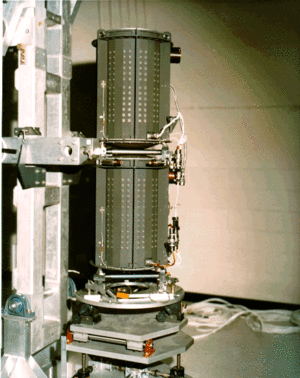
Electrical power comes from three MHW-RTG radioisotope thermoelectric generators (RTGs). These use plutonium-238 as fuel. When launched, they provided about 470 watts of power. Plutonium-238 slowly loses its power over time.
By October 7, 2011, the power from Voyager 1 had dropped to 267.9 watts, and Voyager 2 to 269.2 watts. This was about 57% of their original power. As the electrical power decreases, some spacecraft systems must be turned off. There might not be enough power for communications by 2032.
Voyager Interstellar Mission

Voyager 2 crossed the heliosheath in November 2018.
The main Voyager mission ended in 1989 after Voyager 2 flew past Neptune. The Voyager Interstellar Mission (VIM) is an extended mission that began after the spacecraft had been flying for over 12 years. In 2008, a NASA review said that continuing the VIM was "absolutely imperative."
The main goal of the VIM was to explore beyond the outer planets. This included reaching the heliopause, which is the boundary where the Sun's influence ends. Voyager 1 crossed this boundary in 2012, and Voyager 2 followed in 2018. Passing the heliopause allowed both spacecraft to measure fields, particles, and waves in interstellar space, unaffected by the solar wind. Two important discoveries so far are a region of magnetic bubbles and no sign of an expected shift in the Sun's magnetic field.
The entire scan platform on Voyager 2, including all its instruments, was turned off in 1998. On Voyager 1, all platform instruments except the ultraviolet spectrometer (UVS) have also been turned off. The Voyager 1 scan platform was supposed to be turned off in late 2000 but was kept on to study UV light. UVS data is still collected, but the instrument can no longer scan.
Gyro operations ended in 2016 for Voyager 2 and in 2017 for Voyager 1. Gyros were used to spin the probe around to measure its own magnetic field. This measurement was then removed from the science data.
On November 14, 2023, Voyager 1 stopped sending all data, though its signal was still there. After months of work, made harder by the 45-hour round trip communication time, the problem was found to be a bad memory chip. New software was written to avoid this bad memory. Engineering data started again on April 20, 2024. Science data from two instruments resumed in May 2024, and full recovery of all powered science instruments happened in June 2024.
The two spacecraft are still working, even with some backup systems no longer active. They can still send back science data from their VIM instruments. Both spacecraft also have enough power and fuel to keep working and collecting data through at least 2026. Even if more instruments need to be turned off, the spacecraft are expected to be able to communicate until 2036, if no new problems occur.
Mission Details
When the VIM started, Voyager 1 was about 40 AU from Earth, and Voyager 2 was about 31 AU away. The VIM has three parts: the termination shock phase, the heliosheath exploration phase, and the interstellar exploration phase.
The spacecraft started the VIM in an area controlled by the Sun's magnetic field. This is the termination shock phase. Far from the Sun, the fast-moving solar wind is slowed down by the wind from interstellar space. The first thing a spacecraft meets from this interaction is the termination shock. Here, the solar wind slows down, and the direction of plasma flow and magnetic field change a lot. Voyager 1 finished this phase in December 2004, at 94 AU. Voyager 2 finished it in August 2007, at 84 AU.
After entering the heliosheath, the spacecraft were in an area still controlled by the Sun's magnetic field and solar wind particles. After passing through the heliosheath, the Voyagers began exploring interstellar space. The outer edge of the heliosheath is called the heliopause. This is where the Sun's influence starts to fade, and interstellar space can be detected.
Voyager 1 is leaving the Solar System at about 3.6 AU per year. It is heading towards the Hercules constellation. Voyager 2 is moving at about 3.3 AU per year, heading south of the ecliptic. The Voyager spacecraft will eventually travel to the stars. In about 40,000 years, Voyager 1 will be within 1.6 light years of a star called AC+79 3888. In 40,000 years, Voyager 2 will be within 1.7 light years of Ross 248. In 296,000 years, it will pass within 4.6 light years of Sirius, the brightest star in our night sky. The spacecraft are not expected to hit a star for a very, very long time.
In October 2020, scientists reported a big, unexpected increase in the density of space beyond the Solar System. The Voyager probes detected this. This suggests that the density change is a large feature of the very local interstellar medium.
Voyager Golden Record
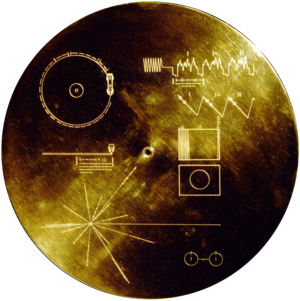
Both spacecraft carry a 12-inch golden record. This record contains pictures and sounds from Earth. It also has symbols on its cover that show how to play it and where Earth is located. The record is like a time capsule and a message to any alien civilization, or even humans far in the future, who might find the Voyagers. A committee led by Carl Sagan chose what went on the record.
Pale Blue Dot
The Pale Blue Dot is a famous photograph of Earth. It was taken on February 14, 1990, by the Voyager 1 space probe. It was taken from about 6 billion kilometers (3.7 billion miles) away. This picture was part of a series of images of the Solar System called the Family Portrait.
The discoveries from the Voyager program, including new color photos of the planets, were often shown in the news. One of the most famous images is the Pale Blue Dot. Carl Sagan helped make this image well-known.
Consider again that dot. That's here. That's home. That's us....The Earth is a very small stage in a vast cosmic arena.... To my mind, there is perhaps no better demonstration of the folly of human conceits than this distant image of our tiny world. To me, it underscores our responsibility to deal more kindly and compassionately with one another and to preserve and cherish that pale blue dot, the only home we've ever known.
See also
 In Spanish: Voyager para niños
In Spanish: Voyager para niños
- Family Portrait
- The Farthest, a 2017 movie about the program.
- Interstellar probe
- Pioneer program
- Planetary Grand Tour
- Timeline of Solar System exploration


